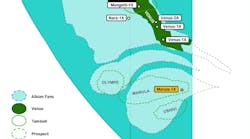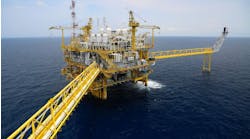Tracy Dulle • Houston
Latin America
The Tot exploration well, 1-ESS-185D, located in the ES-5 block offshore Brazil, is a discovery, according to El Paso Corp.
The Petrobras-operated well is 30 km (18.6 mi) offshore in 61 m (200 ft) of water, and was drilled to 4,521 m (14,834 ft) TVD.
Preliminary evaluation of logs and core analysis suggests a reservoir thickness similar to the main objective in the Camarupim development on the south end of the block. Continuing formation evaluation, including possible drillstem tests, will be forthcoming, the company says.
North Sea
Drilling operations have begun on the Cairngorm discovery area in the UKCS, according to Stratic Energy.
The semisubmersibleByford Dolphin has spudded the Cairngorm well, 16/2b-5, Stratic’s first operated well in the UKCS. Drilling operations are expected to continue for 50 to 60 days, the company says.
The primary target of the 16/2b-5 well is to appraise multiple fracture zones in the granite reservoir that are thought to have been damaged in the 16/3a-11z discovery well, which flowed at rates in excess of 2,000 b/d of oil. The 16/2b5 well has additional secondary exploration objectives in the overlying Palaeocene and Eocene sections, according to Stratic.
Africa
Total has reported positive appraisal results for the Moho Nord Marine-3 well, offshore of the Republic of Congo.
The well was drilled to TD of 2,300 m (7,546 ft) northwest of Moho Nord Marine-2 and north of Moho Nord Marine-1. The well encountered a 60-m (197-ft) column of good quality sands, containing 18°API oil in the Upper Miocene and flowed at 3,000 b/d through a choke, the company says.
This discovery confirms the Tertiary Miocene resource cluster in the northern part of the Moho-Bilondo license. The well will make it possible to further refine the development plan for Moho Nord, according to Total.
Phase 1 development of the southern part of Moho-Bilondo is under way, comprising 14 subsea wells tied back to an FPU. Phase 1 came onstream in April 2008, and should progressively ramp up to a plateau production of 90,000 b/d. Output is exported to the Djéno terminal.
The Ebony-1 exploration well, located offshore Ghana, has intersected two hydrocarbon-bearing intervals in late Cretaceous turbidite sands, according to Tullow Oil.
The well reached a total depth of 2,640 m (8,661 ft). The well lies in the southwest part of the shallow water Tano block in 86 m (282 ft) of water and is Tullow’s second commitment well in this license.
Successful logging and sampling operations have confirmed a 4-m (13-ft) oil bearing interval at 2,053 m (6,736 ft) and a 2-m (6.6-ft) high-pressure gas-condensate interval at 2,570 m (8,432 ft), the company reports.
According to Tullow, log and sample data from the high-pressure gas-condensate sands and a regional seismic interpretation, indicate there may be a connection between these pinched-out sands and the material down-dip Tweneboa oil prospect, which lies mainly in the deepwater Tano license. The company believes other possible interpretations for the high-pressure cannot be excluded at this stage, and data is subject to ongoing evaluation.
Black Sea
ExxonMobil Exploration and Production Romania has signed an agreement with Petrom SA to help explore deepwater portions of the Neptun block offshore Romania.
ExxonMobil and Petrom have agreed to cooperate on a 3D seismic acquisition and evaluation program of the Neptun block. Petrom will operate the initial work program, while ExxonMobil will help fund the work program and provide expertise in evaluating the deepwater seismic data.
Middle East
The Transocean jackupGSF Rig 102 has begun drilling the Dahab North prospect in the East Wadi Araba (EWA) concession offshore Egypt, according to Sea Dragon.
Sea Dragon intends to drill five development wells in the Dahab North prospect and the EWA concession with an initial production rate per well of 4,500 b/d. The company estimates a total of 161.27 MMbbl of undiscovered petroleum to be in place.
PA Resources has made an oil discovery at the Didon North prospect in the Zarat permit offshore Tunisia. The Didon North-1 exploration well was drilled to TD of 3,170 m (10,400 ft) and encountered 14 m (46 ft) of oil pay in the El Gueria formation.
The well was drilled to test two formations -- the El Gueria formation, which is a widely established reservoir formation in Tunisia including the producing Didon field, and the deeper Chouabine formation. The Chouabine formation is currently not a producing reservoir interval in Tunisia.
The top of the El Gueria formation was encountered at 2,797 m (9,176 ft) and the formation has excellent reservoir parameters, the company says. Porosities are in the range of 15 to 22%. Logging and pressure data across the reservoir interval and an oil sample prove the presence of an oil column of 14 m (46 ft). The company reports that the deeper situated Chouabine formation was found to be water bearing. At presstime, the exploration well was being plugged and abandoned.
The recovered well data will be analyzed and reviewed in order to decide the next step for the exploitation of the Didon North discovery, the company says.
Asia
Oil production from the Zhao Dong block, Bohai Bay, offshore China, averaged over 30,000 b/d of oil for the second half of November, according to Roc Oil (Bohai) Co. This production rate was approximately 85% above the average rate of 16,055 b/d of oil achieved from the block during 3Q 2008, the company says.
The production increase is the result of development drilling in the Extended Reach Area (ERA) of the C and D oil fields and the C4 oil field from the new conductor pod and pipeline terminal facilities commissioned in October 2008. During October and November, oil production was established from seven wells that were drilled from the new facilities: six wells in the ERA of the C and D oil fields (ROC interest: 24.5%); and one well in the unitized C4 oil field (ROC interest: 11.575%).
While the production rate has been significantly increased, the underlying natural decline in production at Zhao Dong will continue, the company says. The final two wells in the 2008 Zhao Dong drilling campaign are being completed and are planned to be brought into production in early December. Development drilling has been suspended for the winter period and is planned to recommence in 1Q 2009.
The Song Doc field in block 46/02 offshore Vietnam has achieved first oil, according to Talisman Energy.
Gross production from five pre-drilled wells is expected to reach approximately 25,000 b/d of oil by early 2009, the company says. An additional three development wells are currently being drilled. Talisman’s share of proved and probable reserves in the Song Doc field is estimated at 6 MMbbl of oil, with proved reserves of 3 MMbbl of oil.
The Song Doc field facilities comprise an FPSO and wellhead platform.
The FPSO is a tanker conversion carried out by MODEC at the COSCO yard in Dalian, China. The Song Doc wellhead platform was fabricated by Petroleum Technical Services Co. in Vung Tau, Vietnam.
Talisman has a 30% interest in block 46/02 and in the Truong Son Joint Operating Co., which operates the block. Co-venturers are PetroVietnam Exploration and Production Co. at 40% and Petronas Carigali Overseas Sdn Bhd with the remaining 30%.
ONGC has struck oil with the G-4-6 well at a water depth of 225 m (738 ft). The well is located in nomination Block- IG offshore India.
Based on geological data, log evaluation, and one mini drillstem test, the well encountered three hydrocarbon bearing sands over a gross interval of 3,757 to 4,185 m (12,326 to 12,730 ft). The thickest sand interval comprises 55 m (180 ft) of net oil pay, the company says.
ONGC plans a fasttrack hub development program, clustering geographically proximal finds including G-2, GS-29, Padmawati, and Kanakadurga, using an FPSO. Production is expected to be on course with an initial rate of 20,000 b/d by 2012-13, expected to peak to around 150,000 b/d by 2016-17, the company says.
Australia
The Libra-1 exploration well in permit AC/P41 in the Browse basin, offshore Western Australia, has encountered gas in a series of thick sand packages over a vertical section in excess of 180 m (591 ft) gross, according to Nexus Energy.
The well reached 3,918 m (12,854 ft) total vertical depth subsea in an 8.5-in. (21.6-cm) hole. Further wireline logging and pressure data is required to determine reservoir quality, column height, and hydrocarbon composition, the company says.
BHP Billiton has approved the North West Shelf Cossack, Wanaea, Lambert, Hermes (CWLH) redevelopment project. The project will replace the existingCossack Pioneer FPSO and refurbish selected existing subsea infrastructure and the riser turret mooring.
Upon completion, it also will capture additional oil production from CWLH fields in 75 m to 135 m (245 ft to 440 ft) of water some 135 km (84 mi) offshore Western Australia.
The project is expected to be complete and operational in early 2011.
SBM Offshore NV has signed a turnkey contract to supply the disconnectable FPSO. The FSOOkha will be used for conversion into an FPSO with a disconnectable turret. The vessel currently is under contract with SEIC for operations in Sakhalin until December this year. It will sail to Keppel shipyard in Singapore for conversion and integration of the process modules and turret.
Participants in the project are Woodside Energy Ltd. (33.33%), BHP Billiton Petroleum (North West Shelf) Pty Ltd (16.67%), BP Developments Australia Pty Ltd (16.67%), Chevron Australia Pty Ltd (16.67%), and Japan Australia LNG (MIMI) Pty Ltd (16.67%).
Deepwater spend to exceed $27 billion/year
A new study by energy business analysts Douglas-Westwood, “The World Deepwater Market Report 2009-2013,” forecasts that, despite current oil price concerns, the deepwater oil and gas sector on average will spend over $27 billion annually during the period 2009 to 2013.
“Although we expect some small decline in 2009, thereafter, the deepwater oil and gas industry is set for renewed growth, with annual capex reaching nearly $31 billion in 2011,” John Westwood, chairman of Douglas-Westwood said at the Deep Offshore Technology Conference in Perth, Australia in December. “This is a 45% growth for the 2009-2013 period compared with the previous five years. Deepwater currently accounts for over 15% of total offshore oil production, but over the next few years its relative share will rise to over 20%.”
Africa is expected to be the leading deepwater development area by far, accounting for nearly 40% of the global spend, Westwood said. “Since the first deepwater ‘elephants,’ Africa has emerged as perhaps the most significant deepwater region in the world, with some stunning successes in recent years, such as Girassol, Xikomba, and Kizomba.”
Latin America’s deepwater activity is dominated by Brazil, with its national operator Petrobras achieving production from tremendous water depths, Westwood said. Overall, the region is expected to account for nearly 20% of world deepwater development spend over the 2009-2013 period.
Over the next five years, North America is expected to attract a similar share to Latin America. “With a few notable exceptions, deepwater fields in the US Gulf of Mexico tend to be smaller than those in other deepwater ‘hotspots’ such as Brazil or West Africa. The region’s extensive offshore infrastructure and the relative proximity of supply and service centers have a significant positive influence on E&P activity, turning otherwise marginal prospects into viable commercial propositions.
“The ‘Golden Triangle’ of Africa, Gulf of Mexico, and Brazil will account for three-quarters of global deepwater expenditure over the forecast period. However, the emergence of Asia as a significant deepwater region should not be overlooked. Indonesia, Malaysia and India all have development prospects on screen for the 2009-2013 period and the region should account for nearly 10% of deepwater capex. Western Europe, will maintain its market share but growing activity will see actual expenditure increasing over 30%.”






